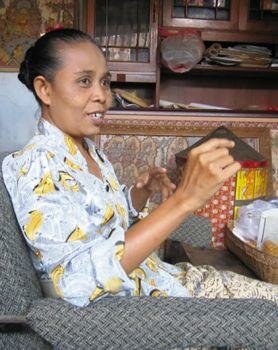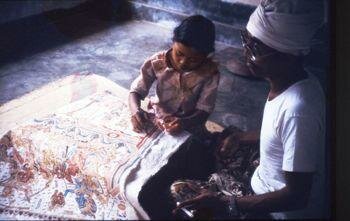Living Traditions
A Balinese artist and temple priest builds on her father’s legacy.
 On a wet afternoon in the village of Kamasan, artist Mangku Muriati is taking a break from painting. Although she has just over a month to finish the commission she is working on, the rain provides an excuse to stop work. Flies have begun to gather on the surface of the painting, attracted by the glue she adds to the paint as a binding agent and the rice starch she uses to prime the cotton cloth. She sits crossed legged on the floor behind a low wooden table, with a section of the five metre long painting in front of her. The cloth is covered in images depicting the temptation of Arjuna, the warrior knight of the wayang tradition. In the past a painting like this was destined to adorn the pavilions of a Balinese temple, but this Kamasan painting has been ordered by a Javanese property developer for a new villa in the south of the island.
On a wet afternoon in the village of Kamasan, artist Mangku Muriati is taking a break from painting. Although she has just over a month to finish the commission she is working on, the rain provides an excuse to stop work. Flies have begun to gather on the surface of the painting, attracted by the glue she adds to the paint as a binding agent and the rice starch she uses to prime the cotton cloth. She sits crossed legged on the floor behind a low wooden table, with a section of the five metre long painting in front of her. The cloth is covered in images depicting the temptation of Arjuna, the warrior knight of the wayang tradition. In the past a painting like this was destined to adorn the pavilions of a Balinese temple, but this Kamasan painting has been ordered by a Javanese property developer for a new villa in the south of the island.
The style of painting Mangku Muriati produces dates back at least to the time of the great East Javanese kingdom of Majapahit, which flourished in the fourteenth and fifteenth centuries. Today, Kamasan remains the only village in Bali where this traditional art form has not been superseded by the adoption of new styles and materials. In her painting style, Mangku Muriati remains faithful to the time-honoured tradition, but her commentaries and choice of subject matter reveal her to be an artist with an astute eye on social and political developments in modern-day Bali.
From father to daughter
Muriati takes her work seriously. As an artist who depends largely on word of mouth for her commissions, and who contributes to the running of a large extended family, she is unwilling to produce work that might diminish her reputation, and her sales. But the financial consequences of producing inferior work are not the only considerations weighing on her mind. She feels the constant presence of her late father overseeing everything she does. Her father, Mangku Mura (1920-1999), was the most famous artist of his generation.
Unlike the other traditional painters of Kamasan, Mangku Mura did not come from a family of artists, and he lived outside Banjar Sangging, the ward of the village where painters have resided for generations. He studied with a number of senior artists from Banjar Sangging, but his studio remained within his family compound in the nearby ward of Banjar Siku. There he was also consecrated as a temple priest of a small clan temple, and he adopted the priest’s title, Mangku, as part of his name. Temples in Banjar Siku are decorated with his work, and his paintings have also been collected by museums nationally and internationally. In 1988 the Indonesian government commissioned him to produce a huge painted world map, which adorned the Indonesian pavilion at the World Expo in Brisbane, Australia.
Born in 1967, Muriati was always close to her father, and from an early age she began to assist him with colouring his paintings. However along with this apprenticeship, Mangku Mura also wanted his daughter to have a formal art school education. Consequently, Muriati was the only one of his seven children to be sent to university. For the best part of six years, she commuted by public transport from Kamasan to Denpasar, a journey of nearly two hours one way, to study fine art at Udayana University. Art school didn’t change her style of painting, but it did help her with technique, particularly the challenges facing Kamasan artists as they move from natural pigments to acrylic paint. A case in point is pere, a natural ochre coloured pigment made from rocks sourced from the island of Serangan, off the south coast of Bali. Since the 1990s, when the island was marked out for property development by Tommy Suharto and a causeway was built to connect it to the mainland, Kamasan artists have been unable to collect the ochre rocks there. Most rely on existing supplies kept buried underground to prevent oxidisation, including Muriati who is fortunate that her father stockpiled enough rocks to ensure she has an ongoing supply. However for other colours like blue and green, which are not sourced naturally, she must rely on the skills she acquired in art school to mix colour from a tube.
After completing her formal education, Muriati wanted to remain in Denpasar and teach Kamasan-style painting to other artists, but her father disagreed. He insisted that she return home and pursue her vocation as an artist from the family compound. Today, she receives a regular stream of visiting students, including large school groups that she hosts in the community hall opposite her house. She also receives invitations to give lectures elsewhere, but she declines most of them, because of her other duties in the village. For not only did Muriati inherit the role of artist from her father, but shortly before he died, he instructed the family that Muriati was also to take on his role as temple priest.
As guardian of her clan temple, Muriati has neither opportunity nor inclination to venture far from the village. She leads temple ceremonies, ensures the temple environs are well maintained, and serves the twenty or so households who make up her congregation. Yet although these responsibilities are time-consuming, being a temple priest is neither a full time job nor a source of income, so it is common for priests to have other employment. Normally, it is only high priests from the Brahmana or priestly caste who can devote themselves fully to religious duties. For Muriati, however, painting and priestly duties are complementary. She is scathing of other temple priests who neglect their duties because they are consumed by income-generating activities.
 New directions
New directions
Not everyone agreed with Mangku Mura’s decision to name his daughter as his successor as temple priest. His decision caused some consternation in the extended family, chiefly among his younger brothers, who questioned his wisdom in nominating his then thirty-two year old daughter ahead of her three older brothers. There are no restrictions on females serving as temple priests in Bali, but it is more common for men to perform this function. The majority of female priests are in fact consecrated when their husbands assume this role. Nevertheless, the unmarried and relatively young Muriati enthusiastically embraced the challenge, and set about learning the sacred texts in preparation for her consecration ceremony. One of the few sources of support in the village for her decision to take on the role came from a female high priest from the ward of Kamasan that is home to Brahmana families. This priest had taught Muriati when she was a pupil at the local primary school in Kamasan, and they had been close associates ever since that time. When she died in 2004, Muriati received the news in a dream, in which the priest symbolically placed her headdress on the ground.

















